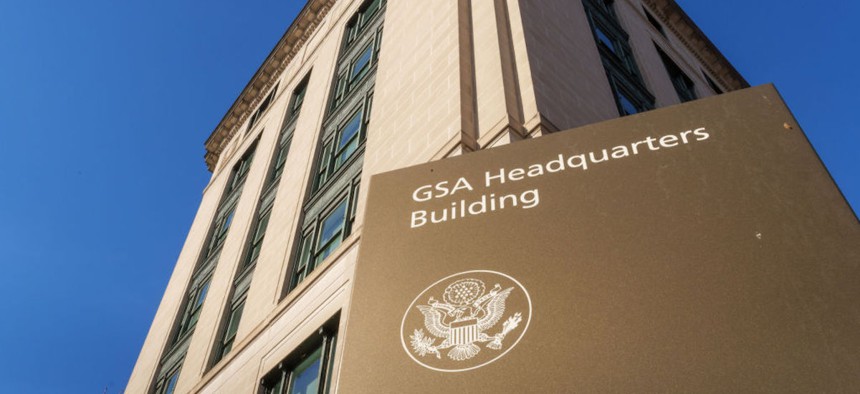GSA prepping plans to move NASA SEWP and NIH contract vehicles under its management

J. David Ake/Getty Images
The General Services Administration’s role in federal acquisition may soon expand further.
The General Services Administration is working with the Office of Management and Budget, NASA and the National Institutes of Health on transfer plans for several major governmentwide contracting vehicles through which more than $100 billion in spending on information technology services flows.
Management of NASA SEWP — the soon-to-be awarded sixth generation of which has a potential $60 billion value — would move under GSA, along with NIH governmentwide contracting vehicles CIO-SP3, CIO-CS and the as-of-yet unawarded $50 billion CIO-SP4, according to plans shared Tuesday in a workforce town hall with select GSA staff.
Per the plans, agencies have also been directed to create proposals for GSA to buy common goods and services — categorized in the Category Management framework — that GSA will review and confer with OMB on. Key considerations will include capacity, performance, success and savings.
“If we get the balance right, GSA can help save tens of billions of dollars more,” according to a slide shared with staff.
In a statement to Nextgov/FCW, GSA Senior Procurement Executive Jeffrey Koses said final decisions are still to come.
"GSA is committed to supporting President Trump’s priorities around streamlining and modernizing the federal acquisition landscape. At this time, no final decisions have been made,” Koses said. “Any potential transitions will be carefully coordinated with our partner agencies and will prioritize continuity for industry partners and federal customers alike. Our shared goal is to reduce duplication and enhance efficiency. As I said in our Workforce Town Hall, GSA is in a position to help save tens of billions of tax dollars for Americans."
In this case, IT governmentwide acquisition contracts, or GWACs, refer to a specific method used by government agencies to buy IT products, services and solutions from external suppliers, contractors and vendors through pre-competed opportunities.
NASA’s SEWP, or Solutions for Enterprise-Wide Procurement, originated in 1993. The current SEWP V contract has 100-plus pre-competed prime contract holders and, according to data from GovTribe, has a combined obligation of more than $69 billion in awarded task orders against it. Large customer agencies for SEWP V include the Veterans Affairs and Justice departments, as well as the National Institute of Standards and Technology, and agencies most frequently buy cloud services, software license renewals and cybersecurity tools from that contract.
Contractors receiving the most award dollars from SEWP V include FCN, Inc., Thundercat Technology, Emergent, V3Gate and Four Points Technology, each with more than $3 billion in obligations. SEWP V expires in October.
NASA has ambitious plans for SEWP VI, such as the addition of standalone IT services, which will help the agency shift away from using separate contracts for services. NASA will now get the bulk of its IT support directly through SEWP.
The agency also expects to increase the number of prime contractors from 147 on SEWP V to 1,000 on SEWP VI.
To get ready for this leap, the SEWP program office has added personnel and is revamping many of its processes, including creating more storefronts, which are agency specific portals for goods and services.
The 147 companies currently on SEWP represent over 10,000 product companies. SEWP adds about 15 a week, according to Joanne Woytek, program director for SEWP, who spoke at a Washington Technology Power Breakfast in December.
CIO-SP3, which stands for Chief Information Officer, Solutions and Partners 3, is managed by the NIH Information Technology Acquisition and Assessment Center and has been extended through April 2026. GovTribe data indicates CIO-SP3 has a combined $18 billion in obligated dollars against it for a wide range of IT services. Health and Human Services component agencies are typically its largest customers, though the Cybersecurity and Infrastructure Security Agency and Justice Department also use the contract.
The top contractors securing orders on CIO-SP3 are Deloitte Consulting, Accenture Federal Services, Booz Allen Hamilton, CGI Federal and Peraton.The CIO-SP4 contract has been mired in years of protests over how NITAAC has used a self-scoring methodology to pick winners and losers. Hundreds of protests were filed with the Government Accountability Office and, when companies were not happy with the corrective actions NITAAC took, many went to the U.S. Court of Federal Claims.
The cases are on hold with NITAAC facing a July deadline for coming back to the court with a plan to resolve the companies’ complaints.
NITAAC has extended CIO-SP3 through April 2026.
GSA’s growing role in government
Moving these large, widely-used IT GWACs under GSA signals further expansion of the agency’s role in government acquisition, which has already grown immensely following executive action in late March that centralized many government procurement functions within the agency.Moving the GWACs under GSA could significantly impact several hundred government contractors that hold positions on them, but President Donald Trump’s March 20 executive order suggested such a move could occur.
“The [GSA] Administrator, in consultation with the Director of OMB, shall defer or decline the executive agent designation for Government-wide acquisition contracts for information technology when necessary to ensure continuity of service or as otherwise appropriate,” the order stated. “The Administrator shall further, on an ongoing basis and consistent with applicable law, rationalize Government-wide indefinite delivery contract vehicles for information technology for agencies across the Government, including as part of identifying and eliminating contract duplication, redundancy, and other inefficiencies.”
Meanwhile, GSA is also playing a major role in rewriting Federal Acquisition Regulation and has secured discounted software rates for government customers from three major tech companies thus far — Google, Adobe and Salesforce — through its nascent OneGov strategy.
Washington Technology Editor-in-Chief Nick Wakeman contributed to this story.
NEXT STORY: CBP previews traveler vetting software recompete


